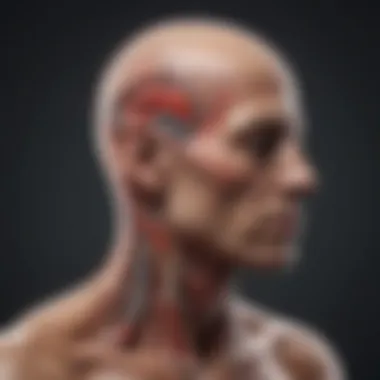Exploring the Link Between Migraines and Chest Pain


Intro
Migraines are often associated with excruciating headache pain, light sensitivity, and nausea. What many people may not realize is that migraines can also lead to symptoms that occur in other parts of the body, such as the chest. This connection between migraines and thoracic discomfort is not as widely recognized, even among healthcare professionals. Exploring this relationship can not only improve understanding but also enhance the approach to treatment and management strategies.
Key Findings
Research indicates that there is a notable association between migraines and chest pain. Many patients who experience migraines report thoracic pain during or following a migraine attack. This chest pain can manifest as tightness, pressure, or even a stabbing sensation, leading to confusion as patients may mistake these symptoms for more serious conditions such as heart disease.
Major Results
- In a cohort study, approximately 25% of migraine sufferers reported chest discomfort during migraine attacks.
- The intensity of chest pain was often correlated with the severity of the migraine episode.
- Research suggests that both migraines and chest pain share similar pathophysiological mechanisms, possibly involving neurovascular components.
Discussion of Findings
The findings highlight that the relationship between migraines and chest pain is complex and warrants further investigation. It is crucial for practitioners to recognize the potential for non-headache symptoms in migraine patients. Misinterpretation of these symptoms could lead to unnecessary medical interventions or distress.
Methodology
Understanding the link between migraines and chest pain requires rigorous research and analysis. The following sections detail the research design and data collection methods that were utilized in relevant studies.
Research Design
Most studies investigating this phenomenon adopted a cross-sectional design, allowing for an examination of a population at a single point in time. This method is beneficial for identifying associations between migraines and accompanying symptoms like chest pain.
Data Collection Methods
Data was often gathered through self-reported questionnaires, neurological examinations, and patient medical histories. Participants were asked about their migraine history, the nature of their chest pain, and any medications they were using.
Through precise methodologies, researchers aim to clarify how migraines can indeed influence broader physiological responses in the body. Understanding these relationships emphasizes the importance of a holistic view in migraine management.
"An increased awareness of chest pain as a potential migraine symptom can lead to better patient outcomes and more effective treatment strategies."
In summary, this exploration into the connection between migraines and chest pain sheds light on the complexity of migraine manifestations. It underlines the necessity for healthcare professionals to adopt a multifaceted perspective in dealing with migraine sufferers.
Understanding Migraines
Understanding migraines is essential for grasping the multifaceted nature of this neurological condition. It is not merely a headache; instead, it involves complex interactions within the body that can lead to various symptoms, including, at times, chest pain. Through a thorough exploration of migraines, we can appreciate their distinct characteristics, triggers, and treatments.
Migraines are often misunderstood, even by those who suffer from them. Many people associate migraines only with intense headache pain. However, the reality is far more complex. This section will cover key elements like the definition of migraines, their symptoms, and their types.
Definition and Symptoms
Migraines are chronic neurological disorders defined by recurrent episodes of headache. The pain can be severe and is usually accompanied by other symptoms such as nausea, vomiting, and sensitivity to light and sound. The definition encapsulates the unique nature of this condition: it is not just about head pain, but rather a constellation of symptoms that can vary significantly among individuals.
Common symptoms include:
- Aura: Visual disturbances such as flashing lights or zigzag lines that may precede the headache.
- Unilateral Pain: Throbbing pain, often localized to one side of the head.
- Nausea: Many patients experience gastrointestinal discomfort.
- Sensitivity: Increased sensitivity to light, sound, and even some smells.
Notably, symptoms can vary in intensity and duration, leading to further complications in diagnosis and treatment.
Types of Migraines
Migraines can be categorized into different types based on their specific characteristics. The two primary types are:
- Migraine with Aura: This type involves neurological symptoms that precede or accompany the headache. Individuals may experience visual distortions, sensory changes, or motor function problems.
- Migraine without Aura: This is the more common form, characterized only by the headache and associated symptoms, without any warning signs beforehand.
In addition, there are specialized types like:
- Chronic Migraines: Occurring 15 days or more per month.
- Hemiplegic Migraines: These can cause temporary paralysis on one side of the body.
Understanding these distinctions is crucial, as they inform treatment decisions and help in recognizing potential complications like chest pain. Knowing what type of migraine one has can lead to better management strategies and improved quality of life.
The Physiology of Pain
Understanding the physiology of pain is crucial in the context of migraines and how they might contribute to chest pain. Pain is not just a physical sensation; it involves complex processes that include both the nervous system and chemical interactions in the body. Recognizing these mechanisms helps in understanding why migraines may result in chest discomfort, thereby aiding in better treatment approaches. A nuanced understanding of pain physiology can inform both medical practices and patient self-management strategies.


Neurological Pathways
The neurological pathways involved in pain transmission are intricate and multifaceted. When a migraine occurs, certain neurons become activated, often in the brainstem, leading to the perception of pain. These neurons release neurotransmitters which can influence pain pathways throughout the body.
For instance, Trigeminal nerve activation is frequently implicated in migraines. This nerve carries sensation from the face and supplies the muscles involved in chewing. When activated during a migraine, it may lead to referred pain, which can manifest in areas other than the head, such as the chest.
"Pain is a complex construct involving nerve signaling and brain processing, far beyond simple injury."
The pathways that manage pain do not operate only through direct activation. They can also be influenced by factors such as stress and anxiety, which are known to exacerbate migraine conditions. Hence, evaluating these pathways helps clinicians create tailored interventions that may reduce both migraine and associated chest pain.
Chemical Mediators in Pain
Chemical mediators play a significant role in how pain is experienced, especially as it pertains to migraines. Various substances, including prostaglandins, serotonin, and neurotransmitters, are released during a migraine attack. These substances facilitate the communication of pain sensations between nerves and the brain.
Serotonin, for example, is a chemical that can modulate pain perception. Low levels of serotonin are often reported in individuals experiencing migraines. This deficit can heighten the pain response. Understanding these chemical interactions is vital, as it provides insights into why some individuals may experience chest pain during migraine episodes.
Additionally, inflammatory markers can also become elevated during migraines. This inflammatory response may contribute not only to headache but also to thoracic pain, reflecting a broader impact of the migraine beyond just the head.
Common Misconceptions
Understanding the common misconceptions surrounding migraines is crucial for both patients and healthcare providers. Misunderstandings can lead to inadequate treatment and misdiagnosis. Migraines are not merely severe headaches; they are a neurological condition that can present a variety of symptoms, including chest pain. This section aims to clarify these misconceptions and emphasize the importance of accurate information in managing migraines.
Migraines vs. Common Headaches
Many people equate migraines with general headaches. This oversimplification can hinder effective treatment. While both conditions involve head pain, their characteristics and implications differ significantly.
Migraines are often accompanied by other neurological symptoms, such as nausea, vomiting, and sensitivity to light or sound. Common headaches, like tension headaches, usually present with a different symptom profile. Tension headaches are often bilateral and can cause a "tight" or "pressure-like" pain. In contrast, migraines can be unilateral, and the pain is commonly described as throbbing.
- Duration: Migraines can last for hours to days, while tension headaches usually resolve within a day.
- Intensity: Migraines typically involve more intense pain, sometimes forcing individuals to seek a dark, quiet room.
- Triggers: Certain triggers may cause migraines, such as certain foods, hormonal changes, or stress, while tension headaches are often related to muscle tension.
This distinction is important because it helps in formulating an appropriate treatment plan. Misclassifying the condition can lead to ineffective treatments or ongoing pain.
Understanding Aura and Non-Aura Symptoms
Another misconception is that all migraines include an aura. Aura refers to transient neurological symptoms that can precede or accompany migraines. These may include visual disturbances, sensory changes, or even speech difficulties. However, not all migraine sufferers experience aura.
- Aura Symptoms: Common aura symptoms could be flashing lights, zigzag patterns in vision, or tingling sensations in the face or limbs.
- Non-Aura Migraines: Many individuals experience migraines without aura. These instances still feature severe pain and associated symptoms but do not include visual or sensory disturbances.
The recognition of these different types is essential for diagnosis and management. If health professionals assume every migraine suffers an aura, it may lead to inadequate treatment options for those who do not. Therefore, understanding both aura and non-aura symptoms is vital for effective communication between patients and healthcare providers. This clarity ultimately promotes better management and helps patients to cope with their conditions more effectively.
Key Insight: Not all migraines are the same, and recognizing the various symptoms can significantly affect treatment outcomes.
In summary, breaking down misconceptions about migraines fosters better awareness and understanding. By distinguishing between migraines and common headaches, as well as between aura and non-aura types, healthcare discussions become more productive, leading to improved care strategies.
Migraines and Chest Pain: The Connection
Understanding the link between migraines and chest pain is essential for both medical professionals and patients. This connection can complicate the clinical picture and lead to misdiagnosis if not better understood. Migraines are traditionally regarded as debilitating headache disorders, yet they can manifest with unusual symptoms, including chest pain. This can confuse both the patient and healthcare provider, often diverting attention from the underlying neurological condition.
Recognizing these symptoms and their association with migraines may significantly improve the quality of care. The exploration of this linkage also sheds light on possible mechanisms and patterns of pain transmission that can be beneficial for targeted diagnosis and effective management.
Mechanisms of Pain Transmission
The transmission of pain in the context of migraines and chest pain is intricate. Migraines primarily involve the trigeminal nerve system, which is significant in processing pain signals from the head and neck area. When a migraine attack occurs, it triggers a cascade of chemical reactions that can affect various bodily systems, including the cardiovascular system. This interplay can lead to sensations of chest pain.
Several mechanisms are thought to be involved:
- Neurogenic Inflammation: This occurs when the trigeminal system becomes sensitized, and inflammatory substances are released. These substances can affect the thoracic region, causing discomfort or pain in the chest.
- Autonomic Dysregulation: Migraines can lead to alterations in autonomic function. These alterations can manifest physically, sometimes resulting in chest tightness or pain, due to changes in heart rate and blood pressure.
- Referred Pain: Chest pain might also be a result of referred pain, where pain signals originating in the head translate to discomfort in the chest region. This can happen due to the overlapping nerve pathways in the central nervous system.
The recognition of these pathways can aid practitioners in understanding their patients' experiences. It can also guide them in distinguishing between typical migraine symptoms and those that may require further investigation.
Associated Symptoms of Migraines
Recognizing the associated symptoms of migraines is crucial in understanding their broader impact on health. While typical migraine symptoms include throbbing headache, nausea, and sensitivity to light and sound, patients may also report atypical symptoms such as chest pain. This association is often overlooked, leading to inadequate treatment plans.
Some other symptoms that may present alongside migraines include:
- Palpitations: Some individuals experience increased heart rate, which may be misinterpreted as anxiety or panic.
- Breathing Difficulties: Chest discomfort can sometimes co-occur with the sensation of shortness of breath or tightness.
- Gastrointestinal Issues: Symptoms like nausea or vomiting may worsen during migraine episodes, which can distress patients further.


Understanding these related symptoms can improve the clinical approach towards migraine management. A thorough symptom review allows for a more holistic view of the patient's experience. If clinicians remain attentive to these potential signs, they may offer more effective strategies that extend beyond conventional headache treatments.
When faced with chest pain during a migraine attack, clinicians should consider all possible factors, including underlying cardiac issues. This ensures a comprehensive diagnostics approach and proper patient care.
Clinical Manifestations
The exploration of clinical manifestations related to migraines and chest pain reveals critical insights into how these conditions interconnect. It is essential to understand the specific elements that comprise this intersection. Recognizing these manifestations can greatly influence treatment approaches and foster a deeper understanding of patient experiences. The complexity of symptoms often leads to challenges in diagnosis and management.
Chest Pain During Migraines
Chest pain experienced during migraines can manifest in various ways. Patients may describe it as a dull ache or sharp discomfort, often localized to a specific area of the chest. This symptom may arise in tandem with typical headache symptoms, making it hard to pinpoint its source. The pain can sometimes mimic conditions like angina or myocardial infarction, thus complicating the clinical picture.
Several mechanisms might explain this phenomenon. Often, vasodilation occurring in the cranial blood vessels may also influence thoracic blood circulation. This connection between the head and the chest could elucidate why some migraine sufferers experience discomfort in both areas. Moreover, the alterations in neurotransmitters, particularly during a migraine attack, might play a role in inducing chest pain.
Understanding that some migraine patients may also experience thoracic discomfort is crucial. It underscores the importance for clinicians to delve deeper into patient history and symptomatology. The effective management of migraines cannot overlook these manifestations, as they significantly impact a patient’s quality of life.
Differential Diagnosis
The differential diagnosis of chest pain during a migraine is paramount for effective clinical practice. Several conditions may present similarly, necessitating a careful and comprehensive evaluation. These can include:
- Cardiac disorders such as ischemic heart disease
- Pulmonary issues including pulmonary embolisms or pleuritis
- Gastrointestinal causes like acid reflux or peptic ulcers
- Musculoskeletal conditions including costochondritis or cervical spine disorders
It is vital for healthcare professionals to distinguish between these potential causes and migraine-related chest pain. Misdiagnosis can lead to inappropriate treatment strategies or unnecessary anxiety for patients. Medical practitioners should consider taking a detailed history and potentially ordering diagnostic imaging or other tests to rule out serious conditions.
"Chest pain in conjunction with migraines should prompt thorough investigation to avoid misdiagnosis and ensure appropriate management."
Risk Factors
Understanding the risk factors associated with migraines and chest pain is crucial. This section aims to analyze various factors that contribute to the likelihood of experiencing these conditions together. Identifying these risk factors can assist healthcare providers in early diagnosis and improve patient management strategies. Moreover, patients can gain insights into their own experiences by learning about these elements.
Demographics and Genetics
Demographics play a significant role in how migraines and chest pain present in different populations. Age, sex, and family history are prominent demographic factors. For instance, studies show that women are more likely to experience migraines than men, with a ratio as high as 3:1. This gender disparity could be linked to hormonal fluctuations which affect migraine frequency and intensity.
Genetic predisposition is another critical component. Research indicates that migraines often run in families, hinting at a hereditary link. If a parent experiences migraines, the offspring may have a higher chance to develop similar conditions, including episodes of chest pain. Recent genome-wide association studies have identified specific genes associated with increased migraine susceptibility, suggesting a biological underpinning for this connection.
While demographics and genetics are significant, it is essential to remember that they are not deterministic. Individuals may experience migraines and chest pain without having a genetic background, and vice versa. Hence, a thorough examination of each patient's unique circumstances is vital in clinical practice.
Environmental and Lifestyle Factors
Environmental and lifestyle factors also influence the frequency and severity of migraines and chest pain. Triggers such as stress, sleep deprivation, and diet can play a pivotal role. High-stress situations are known to exacerbate migraine attacks, potentially leading to associated chest pain. Furthermore, irregular sleep patterns can disturb the body's natural rhythm, heightening the risk of migraine episodes.
Dietary choices are crucial as well. Certain foods like aged cheeses or processed meats may trigger migraines in susceptible individuals. Additionally, dehydration can lead to increased headache frequency, impacting the thoracic area due to referred pain sensations.
Other lifestyle factors, such as physical inactivity, smoking, and alcohol consumption, contribute to the risk of experiencing both conditions. Maintaining a healthy lifestyle may help mitigate risks. Thus, a multifactorial approach is encouraged in managing these health concerns effectively.
Key Takeaway: Identifying risk factors helps in better understanding the link between migraines and chest pain. By controlling modifiable factors, individuals can improve their overall wellbeing and might reduce the occurrence of these symptoms.
Research Insights
Understanding the intersection between migraines and chest pain is crucial for both medical professionals and patients. The link between these two conditions is not commonly addressed in clinical practices, which can lead to inadequate management of symptoms. This section aims to shed light on the significance of recent research findings. It highlights the potential for enhanced patient care and opens avenues for new therapeutic strategies. By gathering insights from studies, we begin to paint a clearer picture of how migraines may extend beyond headache experiences. This deeper understanding is beneficial for creating tailored treatment plans.
Recent Studies on Migraines and Chest Pain
Recent studies have begun to illuminate the complex relationship between migraines and chest pain. For instance, research shows that individuals with migraines may experience thoracic discomfort as part of their symptoms. A study published in the journal Headache revealed that a notable percentage of migraine patients reported chest pain during attacks. These episodes of discomfort were often accompanied by symptoms traditionally associated with migraines, such as nausea and light sensitivity.
The mechanisms underlying this connection remain a subject of exploration. One proposed explanation is that migraine-related changes in blood flow can also influence the thoracic area. Another aspect is the involvement of the autonomic nervous system, which plays a role in both headaches and thoracic sensations, leading to overlapping symptoms that complicate diagnosis and management.
"Studies indicate that chest pain in migraineurs may not merely be psychosomatic but could reflect physiological processes related to migraines."
Implications for Future Research
The implications of these findings for future research are significant. First, they suggest the need for more comprehensive clinical guidelines that take chest pain into account. Current migraine treatments may need revision to accommodate patients experiencing this symptom. Furthermore, future studies could explore the effectiveness of specific treatments, such as beta-blockers or certain anticonvulsants, on both migraine pain and associated chest pain.
Focus areas for further investigation include:


- The role of inflammation in both migraines and chest pain.
- Patterns of chest pain occurrence in different types of migraines.
- Longitudinal studies examining how chronic migraines impact cardiovascular health.
By directing more research efforts toward the interplay of these symptoms, we can enhance patient care strategies, improve quality of life, and prevent misdiagnosis. Overall, this area of study is ripe for exploration, promises to broaden our understanding, and emphasizes the importance of an integrative approach in migraine management.
Management Strategies
The management of migraines, particularly in relation to associated chest pain, is crucial for improving patient outcomes. Managing migraines effectively can alleviate not only headache symptoms but also reduce the risk of related thoracic discomfort. Successful management strategies often encompass both medical interventions and lifestyle modifications, allowing for a thorough approach.
Medical Interventions
Medical interventions for migraines typically involve a range of therapies aimed at reducing the frequency and severity of migraine attacks. These include:
- Abortive Medications: These are taken during a migraine attack to relieve symptoms. Commonly used options are triptans, such as sumatriptan and rizatriptan, which work by narrowing blood vessels and blocking pain pathways in the brain.
- Preventive Medications: Preventive treatment options are important for individuals experiencing frequent migraines. Common preventive medications include topiramate, verapamil, and certain antidepressants. These can reduce the overall frequency of migraines, thus potentially decreasing the likelihood of accompanying chest pain.
- Botulinum Toxin Injections: Botulinum toxin type A has been approved for chronic migraine management. This involves periodic injections into specific areas of the head and neck to reduce muscle tension and pain.
- CGRP Inhibitors: Recently, medications targeting calcitonin gene-related peptide (CGRP) have emerged. Drugs like erenumab and fremanezumab offer another avenue of abortive and preventive therapy.
Alongside these medications, it is essential for patients to communicate effectively with healthcare providers about their symptoms and any potential pain experienced in the chest area. This will aid in creating a tailored management plan.
Lifestyle Modifications
Managing migraines through lifestyle modifications can be just as effective as medical interventions. Patients may consider various adjustments in their daily routines, which can diminish the intensity and frequency of migraine episodes.
- Dietary Changes: Certain foods are known triggers for migraines, such as aged cheeses, processed meats, and caffeine. Keeping a food diary may help identify personal triggers that can be eliminated or reduced.
- Regular Exercise: Engaging in regular physical activity not only helps reduce stress but can also diminish migraine frequency. A routine that includes aerobic activities like walking or swimming is beneficial.
- Sleep Hygiene: Maintaining a regular sleep schedule is vital. Inconsistent sleep patterns can trigger migraines, thus prioritizing adequate rest is important.
- Stress Management: Stress is a significant trigger for many migraine sufferers. Techniques such as yoga, meditation, or deep-breathing exercises can help control stress levels effectively.
- Hydration: Keeping well-hydrated is a simple yet effective way to help prevent migraines. Dehydration is a known trigger, so drinking sufficient water throughout the day is important.
"Effective management of migraines requires both medical understanding and personal adjustments."
Observing and understanding one's own triggers and responses is essential for an informed strategy towards reducing health complications associated with migraines.
Psychological Dimensions
Understanding the psychological dimensions of migraines and their potential to cause chest pain is crucial in grasping the full scope of this condition. Migraines are not purely physical ailments. Psychological factors can greatly influence their occurrence and intensity. Stress has a notable impact on migraine frequency and severity. Chronic stress, for example, can act as a trigger, worsening symptoms, and potentially leading to the experience of atypical manifestations such as chest pain.
Recognizing the role mental health plays in migraines can help in creating effective management strategies. Patients may find that cognitive behavioral therapy (CBT) or stress management techniques can help reduce both the frequency of migraines and the associated chest pain. This intersection of mental and physical health needs greater attention in the clinical setting.
Moreover, understanding psychological dimensions informs healthcare professionals about the broader spectrum of migraine management. This involves not only treating the physical symptoms but also addressing the emotional and psychological aspects of living with chronic migraines.
The Role of Stress in Migraines
Stress is a well-documented trigger for migraines. When a person experiences high levels of stress, whether from personal life challenges, work pressure, or other sources, the body enters a state of heightened alert. This can lead to a cascade of physiological responses, such as increased muscle tension or adrenaline production, which may precipitate migraines.
Individuals suffering from chronic migraines often report that managing their stress levels results in fewer episodes. Techniques to reduce stress, such as mindfulness practices, yoga, and regular physical activity, can be beneficial.
People need to recognize the signs of stress early and address them. The inability to effectively handle stress can lead to a vicious cycle, where migraines aggravate stress, leading to more migraines. This cyclic relationship warrants a comprehensive approach to treatment.
Psychosomatic Connections
Psychosomatic connections refer to the interplay between psychological factors and physical symptoms. Migraines can manifest physical sensations that are exacerbated by mental state. This means that psychological distress can lead to physical discomfort, like chest pain.
Research shows that individuals with anxiety or depression are more susceptible to migraines. They may also experience more intense symptoms, including chest pain, due to the heightened perception of pain associated with these mental states.
Also, while chest pain can occur during migraines, it is essential to distinguish it from other medical conditions. Awareness is crucial, and patients should consult medical professionals if they experience this symptom. Understanding psychosomatic connections emphasizes the need for a holistic approach to treatment, considering both the mind and body.
"Migraines often encompass a spectrum of symptoms, challenging the traditional view of headaches as purely physical. Exploring the psychological aspects can lead to better management strategies."
Culmination
Understanding the relationship between migraines and chest pain carries notable significance within medical discourse. This conclusion synthesizes the complexities discussed throughout the article, emphasizing several key elements that merit further consideration.
First, the symptoms associated with migraines extend past the typical isolation of head pain. This article has illuminated how chest pain may coexist with migrainous episodes. Acknowledging this can lead to more accurate diagnoses and appropriate management strategies.
Second, the need for further research cannot be overstated. While this article presents a framework for understanding the connection, numerous questions remain unanswered. Continued investigation into the underlying mechanisms that link migraine pathology with thoracic discomfort is essential.
Lastly, it is crucial for both patients and healthcare providers to adopt a comprehensive approach towards migraine management. This includes patient education about possible atypical symptoms such as chest pain, which can often lead to misinterpretations and unnecessary anxiety.
"The mind and body are not separate. what affects one affects the other."
In summary, by spotlighting the unexpected connection between migraines and chest pain, this article highlights the importance of informed patient care and ongoing research endeavors.
Summary of Findings
The findings throughout this article suggest that while migraines are predominantly recognized for their neurological manifestations, they can also cause significant thoracic discomfort. Various mechanisms, including altered neurological pathways and chemical mediators, may be involved in this phenomenon. Furthermore, associated symptoms align closely with the complex nature of migraine conditions. Understanding these nuances will aid practitioners in recognizing the broader implications of migraine aims.
Next Steps for Research and Practice
Future research should focus on exploring how different patient demographics experience migraines and associated chest pain. Studies aimed at identifying triggers, effective management techniques, and how psychosomatic factors contribute to these experiences will provide additional insights. Medical practitioners should integrate this knowledge into their practice by fostering a dialogue with patients about comprehensive symptoms, thus leading to enhanced treatment plans. Adjusting lifestyle modifications, medicinal interventions, and stress management strategies while considering these aspects can improve outcomes for individuals suffering from migraines.



